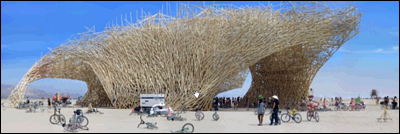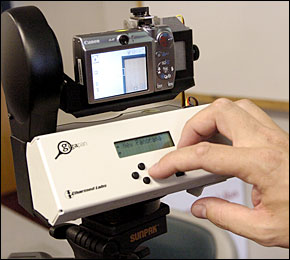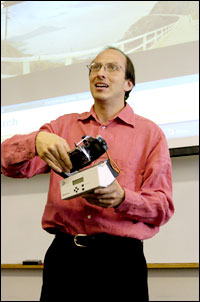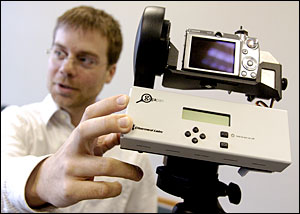
GigaPan Cameras Unveiled
A low-cost robotic device enables any digital camera to produce breathtaking gigapixel (billions of pixels) panoramas, called GigaPans.
The technology, built by researchers at Carnegie Mellon University in collaboration with scientists at NASA’s Ames Research Center, gives people a new way to make and share images of their environment. It is being used by students to document their communities and by the Commonwealth of Pennsylvania to make Civil War sites accessible on the Web. To promote further sharing of this imagery, Carnegie Mellon has launched a public Web site, www.gigapan.org, where users can upload and interactively explore panoramic images of any format.

Panorama of the Waffle at Burning Man 2006 arts festival, Black Rock Desert of Nevada, Jan. 29, 2007. Photo: James Bell. Stitched by Scott Telstad. Field of view: 84.06 degrees wide, 30.41 degrees high (gigapan.org)
In cooperation with Google, researchers have also created a GigaPan layer on Google Earth. Anyone using Google Earth can now "fly" into these GigaPan panoramas in the context of exploring the world.
Researchers have begun a public beta process with the GigaPan hardware, Web site and software. The hardware technology enabling GigaPan images is a robotic camera mount, jointly designed and manufactured by Charmed Labs of Austin, Texas. The tripod-like mount makes it possible for a digital camera to take hundreds of overlapping images of landscapes, buildings or rooms. Then, using software developed by Carnegie Mellon and Ames, these images can be arranged in a grid and digitally stitched together into a single image that could consist of tens of billions of pixels.

A low-cost robotic device enables any digital camera to produce GigaPans. (Photo: Carnegie Mellon University/Ken Andreyo)
These huge image files can then be explored by zooming in on features of interest in a manner similar to Google Earth.
“We have taken imagery and made it a new tool for exploration and for enhancing global understanding,” said Illah Nourbakhsh, associate professor in the School of Computer Science’s Robotics Institute.
Nourbakhsh and Randy Sargent, senior systems scientist at Carnegie Mellon West in Moffett Field, Calif., led GigaPan’s development. “An ordinary photo makes it possible to cross language barriers,” Nourbakhsh explained. “But a GigaPan provides so much information that it leads to conversations between the person who took the panoramas and the people who are exploring it and discovering new details.”
The GigaPan camera system is part of a larger effort known as the Global Connection Project, led by Nourbakhsh and Sargent. Its purpose is to make people all over the world more aware of their neighbors. Global Connection’s earlier accomplishments include the publication of the National Geographic magazine photography and the story layer in Google Earth.
Sargent got the idea for GigaPan when he was a technical staff member at Ames Research Center, helping to develop software for combining images from NASA’s Mars Exploration Rovers into panoramas. He became convinced that the same technology could open people’s eyes to the diversity of their own planet. “It is increasingly important to give people a broad view of the world, particularly to help us understand different cultures and different environments,” he said. “It’s too easy to have blinders on and to only see and understand what is local.”
 Last spring, the Pennsylvania Board of Tourism began to use GigaPan to enable people to virtually explore Civil War sites. The technology is also being used for Robot250, an arts-based robotics program in the Pittsburgh area. Robot250 will increase technical literacy by teaching students, artists and other members of the public how to build customized robots.
Last spring, the Pennsylvania Board of Tourism began to use GigaPan to enable people to virtually explore Civil War sites. The technology is also being used for Robot250, an arts-based robotics program in the Pittsburgh area. Robot250 will increase technical literacy by teaching students, artists and other members of the public how to build customized robots.
Illah Nourbakhsh (photo at right) and David Holstius (below) with the GigaPan camera mount. (Photos: Carnegie Mellon University/Ken Andreyo)
Nourbakhsh and his colleagues recently began to work with UNESCO’s International Bureau of Education and its Associated Schools Network on a project that will link school children in different parts of the world in exploring issues of cultural identity through a classroom project. Middle school children from Pittsburgh to South Africa to Trinidad and Tobago will use the GigaPan camera to share images of their neighborhoods, lives and cultures.
 “This project will explore curriculum development from the local to the global level,” said IBE Director Clementina Acedo. “It is an extraordinary opportunity to link a school-community based educational practice with high-end technology in the service of children’s innovative learning, personal development and world communication."
“This project will explore curriculum development from the local to the global level,” said IBE Director Clementina Acedo. “It is an extraordinary opportunity to link a school-community based educational practice with high-end technology in the service of children’s innovative learning, personal development and world communication."
The experiences of these children, from poorer and richer countries, will be presented at the 48th session of the International Conference of Education, set for Geneva in November 2008.
Besides being a tool for education, the GigaPan system is an important tool for ecologists, biologists and other scientists, Nourbakhsh and Sargent said. They plan to foster this effort by making several dozen GigaPans available to leading scientists with support from the Fine Foundation of Pittsburgh.
Nourbakhsh said he hopes the noncommercial GigaPan site will help to develop a community of GigaPan producers and users. “We’re not interested in becoming just another photo-sharing site. We want as many people as possible involved," he said. "GigaPan is not just about the vision of the person who makes the image. People who explore the image can make discoveries and gain insights in ways that may be just as important.”
For more information, visit: www.cmu.edu
Published: September 2007